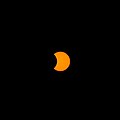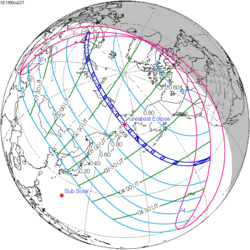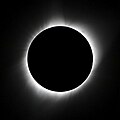| Annular eclipse | |
 Annularity viewed from Churchills Head, Australia. | |
| Gamma | −0.2694 |
|---|---|
| Magnitude | 0.9544 |
| Maximum eclipse | |
| Duration | 363 s (6 min 3 s) |
| Coordinates | 2°12′N175°30′E / 2.2°N 175.5°E |
| Max. width of band | 173 km (107 mi) |
| Times (UTC) | |
| (P1) Partial begin | 21:25:10 |
| (U1) Total begin | 22:30:34 |
| Greatest eclipse | 0:26:20 |
| (U4) Total end | 2:19:58 |
| (P4) Partial end | 3:25:23 |
| References | |
| Saros | 138 (31 of 70) |
| Catalog # (SE5000) | 9537 |
An annular solar eclipse occurred at the Moon's descending node of orbit between Thursday, May 9 and Friday, May 10, 2013, [1] [2] [3] with a magnitude of 0.9544. A solar eclipse occurs when the Moon passes between Earth and the Sun, thereby totally or partly obscuring the image of the Sun for a viewer on Earth. An annular solar eclipse occurs when the Moon's apparent diameter is smaller than the Sun's, blocking most of the Sun's light and causing the Sun to look like an annulus (ring). An annular eclipse appears as a partial eclipse over a region of the Earth thousands of kilometres wide. Occurring about 3.6 days before apogee (on May 13, 2013, at 14:30 UTC), the Moon's apparent diameter was smaller. [4]
Contents
- Visibility
- Eclipse timing
- Places experiencing annular eclipse
- Places experiencing partial eclipse
- Gallery
- Eclipse details
- Eclipse season
- Related eclipses
- Eclipses in 2013
- Metonic
- Tzolkinex
- Half-Saros
- Tritos
- Solar Saros 138
- Inex
- Triad
- Solar eclipses of 2011–2014
- Saros 138
- Metonic series
- Tritos series
- Inex series
- Notes
- References
Annularity was visible from parts of Western Australia, Northern Territory and Queensland, Australia, the Louisiade Archipelago (belonging to Papua New Guinea), the Solomon Islands, and Kiribati. All land within the path of annularity was west of the 180th meridian, except Tabuaeran in Kiribati. However, time zone of the Line Islands including Tabuaeran was changed from UTC−10 to UTC+14 in 1995, so annular eclipse visible from land was completely on May 10.
A partial eclipse was visible for parts of Indonesia, Australia, New Zealand, Oceania, and Hawaii. Part of these areas are west of the 180th meridian, seeing the eclipse on May 10, and the rest east of the 180th meridian, seeing the eclipse on May 9.























































































































